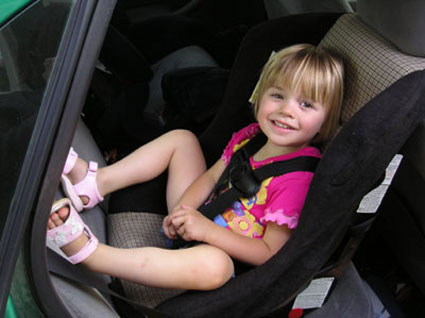Car Seat Safety
The following website contains the most comprehensive information we have found on the web when it comes to car seat safety, and we strongly recommend you read it when purchasing or installing a car seat for your child.
Healthychildren.org: Car Safety Seats: Information for Families
 My Thoughts on the New AAP Car Seat Recommendation by Matthew M. Yaeger, M.D.
My Thoughts on the New AAP Car Seat Recommendation by Matthew M. Yaeger, M.D.
Life is full of risks. Every day, we all evaluate the consequences of risks we take in just about everything we do. We get in our car to drive to work or carpool and we take a risk. Is it worth it? For most people, the answer is "Yes". We buy our children a trampoline. The inevitable orthopedic risk is worth it to many because of the enjoyment their children receive and the benefits the physical activity affords them. We each have our own threshold for these types of risk.
Thus, when I read the recent statement from the American Academy of Pediatrics concerning car seat safety, I immediately started thinking about risk. I had never had a patient properly restrained in a car seat with a 5-point harness have a poor outcome when involved in a car accident. Car seats were so safe. How could we improve upon that? More importantly, perhaps, how could we prove there was such a difference?
I took that skepticism with me as I began to review the AAP's statement and the studies that supported it. Did the studies have large numbers of real-life cases on which to base the conclusions? They certainly did. These were very large studies over an extended period of time, some longer than a decade. They evaluated all types of accidents: frontal, side-impact, rollover. The answers were always the same. Children under the age of 2 restrained in rear-facing car seats universally did better.
But were these Americans? Who knows how the roads and driving habits in another country might affect these outcomes. Even if the results weren't all published in American journals, the data was from American streets, with thousands of accidents evaluated. These weren't theoretical concerns based on crash tests or calculations. These were real lives that we could save.
Was it really that definitive, though? If I'm going to put up with my screaming, uncomfortable 18 month old, there'd better be a pretty good reason. There are lots of ways to analyze the information available, but one simple statement sums it up for me. Your child is four times more likely to have a serious injury or death if they are in a forward facing car seat when compared to rear facing at this age. Luckily, that occurrence is still very rare. However, the difference is so stark that everyone should adhere to this advice and keep their child rear facing as long as their car seat will accommodate them that way. The risk in not doing so is too great.

